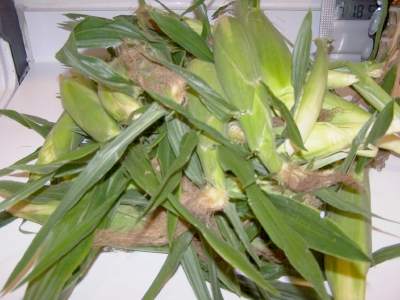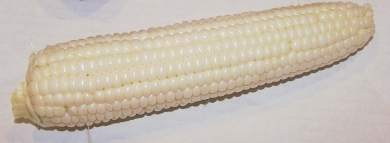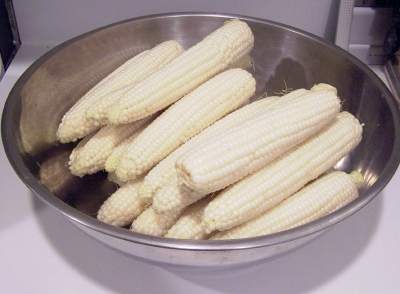
Looking for All You Need to Know About Fresh Corn, Corn on the Cob: Picking, Storing and Cooking in 2025? Scroll down this page and follow the links. And if you bring home some fruit or vegetables and want to can, freeze, make jam, salsa or pickles, see this page for simple, reliable, illustrated canning, freezing or preserving directions. There are plenty of other related resources, click on the resources dropdown above. If you are having a hard time finding canning lids, I've used these, and they're a great price & ship in 2 days.
If you have questions or feedback, please let me know! There are affiliate links on this page. Read our disclosure policy to learn more.
All You Need to Know About Fresh Corn, Corn on the Cob: Picking, Storing and Cooking
 Fresh Corn, Corn on the Cob: Picking, Storing and Cooking
Fresh Corn, Corn on the Cob: Picking, Storing and Cooking
The difference in flavor between fresh, home grown or farm-picked corn and the usual grocery store ear of corn is profound - if - you know how to handle, store and cook it properly. Mishandled, even the best, freshest corn loses its flavor and sweetness. ANd if you'd like to grow your own corn, see this page that includes my 50 years of corn growing experience. So, here's what you need to know!
Choosing and Picking Corn
Corn reaches it's peak sweetness and flavor when the kernels are full, and just touching each other, like a good set of teeth! They should not be bloated and smushed so tightly that there is no space left at all. The bloated overripe ears will have a bland, starchy taste.
If you break a kernel with your fingernail, the liquid should be slightly milky in color. The tips of the silks coming out of the ear should be a light brown.
Harvesting
To harvest, snap off the ears by hand with a quick, firm,
downward push; then twist and pull.

Avoid twisting or yanking
the ears, as this can damage the stalk or the ear itself.
Storing the corn
Corn is at its prime eating quality on the stalk for only 72 hours before becoming over mature. The most important factor is cooling it as soon as possible after harvesting it. Get it into the fridge or cover it with ice! Many farmers say you should remove the shucks right away, too. I've found that removing most of the shuck, but leaving a few leaves to cover each ear is best to prevent the kernels from drying out. See this page for more about storing corn before using it.
Cooking:
The worst mistake people make is overcooking corn. In fact, corn isn't really cooked; it's just heated up. If you cook it form more than a few minutes (3 minutes), then you are simply breaking down the sugars and turning a nice, crisp sweet ear into bland mush. It's not a pot roast; the purpose of heating it is NOT to break down the cells, just to heat them to bring out the flavor and melt the butter!
Here's how to cook the corn:
- Fill a large pot (large enough so the shucked ears can fit inside, laying down) about 2/3 full of water and start bring it to a boil
- Shuck the ears, and snap off the stalk end and the very tip of ear (especially if you will use "corn stickers" , (handles) to hold the ears.
- When everyone is sitting down at the table and you are serving the rest of the meal, put the corn in the boiling water and set the time for 3 minutes.
- After 3 minutes, using tongs, retrieve the ears and serve them with butter (Corn boats are wonderful for corn!
Freezing Corn
You can easily freeze the sweet corn and have that great taste in the dead of winter!
Canning Corn
This too, is easy... but it DOES require a Pressure Canner. You cannot safely do this with a water bath canner. Food poisoning is no joke!
- Here is how to can corn!
- how to make canned creamed corn.
- Southern Chow-Chow (also called Piccalilli)
- Pickled corn relish
Other corn recipes
Looking for canning equipment and supplies?
Water bath canner with a jar rack
Pressure canners for gas, electric and induction stoves: Presto 23Qt or T-fal 22Qt
Canning scoop (this one is PERFECT)
Ball Blue book (most recent version)
Jars: 8oz canning jars for jams
Find Other types of farms:
Farm markets and roadside stands
Road trips and camping resources
Local Honey, apiaries, beekeepers
Consumer fraud and scams information
Home canning supplies at the best prices on the internet!
Maple Syrup Farms, sugarworks, maple syrup festivals
Environmental information and resources
Farms For Your Event for birthday parties, weddings, receptions, business meetings, retreats, etc.
Festivals - local fruit and vegetable festivals
Get the
most recent version of
the Ball Blue Book
With this Presto 23 quart pressure canner and pressure cooker, you can "can" everything, fruits, vegetables, jams, jellies, salsa, applesauce, pickles, even meats, soups, stews. Model 01781

You can make jams, jellies, can fruit, applesauce, salsa and pickles with water bath canners, like this Granite Ware 12-Piece Canner Kit, Jar Rack, Blancher, Colander and 5 piece Canning Tool Set

